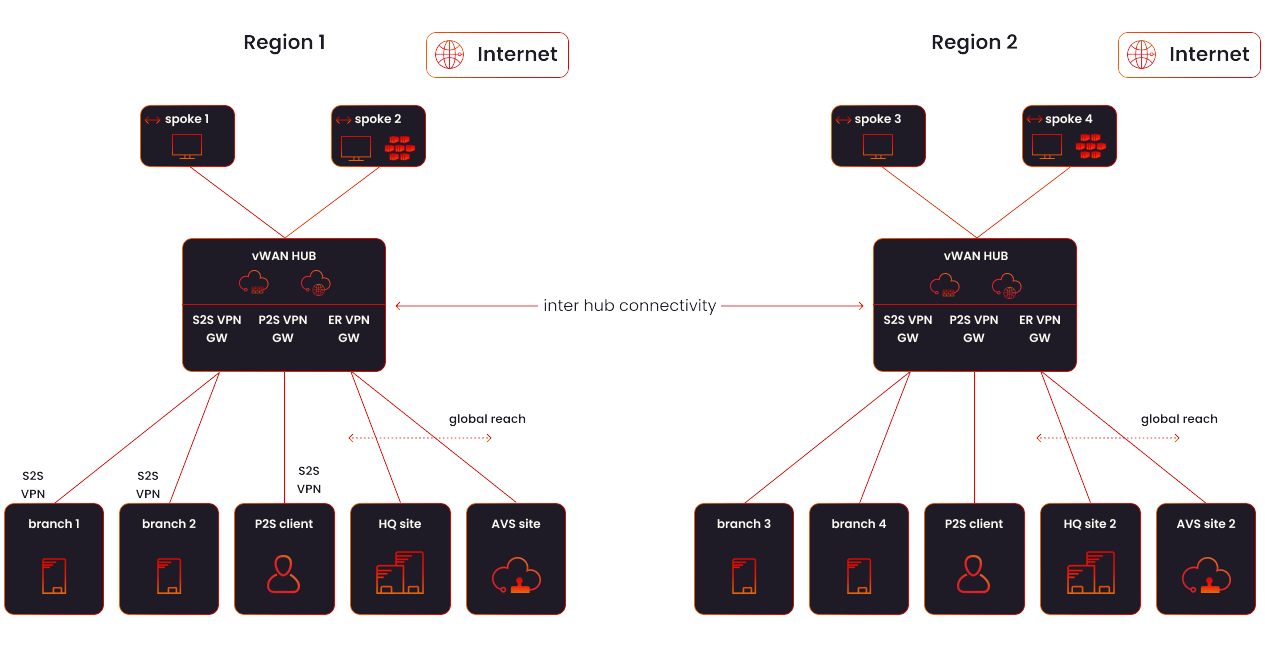When it comes to connectivity, scalability and security, organizations often face an important decision: going for a traditional network architecture or embracing Microsoft Azure’s Virtual WAN. But what should you choose? We’ll help you make the right call for your business. Let’s do a quick deep dive into the benefits and potential issues of the Virtual WAN architecture model.
Virtual WAN is an Azure-based networking service, that is managed by Microsoft. This hub-and-spoke architecture option provides you with optimized, automated and global scale connectivity. But back in 2019 when it first launched, it was still missing some key networking features. And had several limitations in place, making it hard to live up to its promise: “providing a unified framework for networking, security, and routing”.
However, in the last five years, Microsoft has been working very hard to improve the service. They’ve been adding a lot of new features and removing existing limitations, creating many benefits along the way. And now it has reached a point where we consider it our preferred hub-and-spoke network architecture.
But why is that? Let’s take a closer look at the benefits of Azure Virtual WAN and at how we counter any potential challenges.
Before we dive deep into the advantages and disadvantages, let’s check out Azure Virtual WAN’s different services and components. And find out how they provide high-speed connections to the Azure backbone:
Fully meshed hubs where all traffic flows through. Upon creation, you are provided with an address space and routing tables.
This enables cross-region connectivity between all on-prem and Azure network endpoints.
This supports custom route tables for virtual networks. And acts as the default route table for branches (P2S, S2S, ER). It also associates connections to route tables and propagates routes from connections to route tables.
There are several types of possible connections:
This offers added security with the integration of Azure Firewall Manager. It allows you to:
When you combine these services and components, you’re able to create a networking architecture. Offering you secured transit connectivity paths between multiple spokes, branches and regions.

Important to note
Azure Virtual WAN comes in 2 types: basic and standard. At Arxus, we always deploy the standard variation, because the basic one only supports S2S VPN connections.
An Azure Virtual WAN architecture has a lot of advantages:
While Azure Virtual WAN offers many benefits, there are also some possible disadvantages to consider:
As of late, our engineers have been facing a problem: the West-Europe Azure region, located in Amsterdam, is currently experiencing capacity issues. And Virtual WAN is one of the services that is most impacted by this problem. Most of the recent Azure networking projects have suffered initial deployment failures. And forced Microsoft to assign extra capacity for successful deployment.
This problem will become less impactful, once the new datacenters in The Netherlands finish completion. And once the Azure Belgium Central region comes online.
At Arxus, we're committed to helping your business harness the power of cloud networking solutions, like Azure Virtual WAN. We firmly believe that it offers significant advantages over a more traditional hub-and-spoke architecture. But every organization is unique. And requires its own solution.
Our team of experienced cloud architects and networking experts stand at the ready to guide you through the entire process: from initial assessment to deployment and ongoing management.
The digital landscape is changing more rapidly than ever before. So, creating a resilient and flexible cloud infrastructure is key to staying ahead of the game. But where do you even start? With the Azure Resiliency Strategy, powered by the Well-Architected framework, you lay a solid foundation for
Is your IT infrastructure made up of different cloud platforms? Or do you still have some on-prem servers running? Then Azure Arc is the perfect tool for you! It allows you to manage your entire hybrid or multi-cloud environment in the blink of an eye, from one central location. Want to find out
Microsoft has announced that as of Sept. 30, 2025, they will no longer support default outbound connectivity for virtual machines (VMs) and scale sets. And that obviously has significant implications for users who currently (still) rely on it. Wondering why Microsoft made this decision? And what